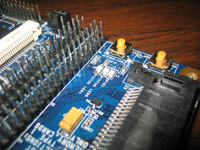
All buildings have a personality, and to a certain extent an office sets the tone for a business, as does its environs. Exbiblio is based on First Avenue in Seattle. I’m told that a couple of decades ago it was a rather seedy area, full of shops selling guns, porn, and worse. Now there are book and art shops. Many have a trendy ethnic feel – tribal masks at fabulous prices – that sort of thing.
Exbiblio is based on the fourth floor of a former hotel. On the ground floor, there is a large airy coffee shop. An impressive staircase with an art-deco carved banister leads up to the office floors. The walls have been taken back to the brick. The carpet smells of newness. Judging by the brass plates, many of the other occupants of the building are lawyers. Exbiblio has a good chunk of the fourth floor. The walls of the reception room are covered in book shelves, mostly bearing classic novels in pristine covers. I noticed the complete cartoons of the New Yorker among the library. One or two well-thumbed computer manuals are often lying around.
One room, which is always be pointed out with pride on a visitor’s tour, is the “meditation room”, which is furnished with orange floor-cushions. It has a glass wall and I have never seen anyone inside it on my way past. Elsewhere there is a table with organic muesli bars and other healthy eats spread out on it. The stationary cupboard contains boxes of various brands of scanner pen, and a good supply of a small book called “The Corporate Mystic”, which is a sort of Exbiblio Bible.
The hardware project has its own small lab, which contains all sorts of impressive looking optical instruments and circuit boards. Even so, part of the scanner pen’s development happens off-site at a contractor called Synapse which is based in a suburb. You’ll often bump into a Synapse person at Exbiblio.
The 15 or so Exbiblio workers inhabit various rooms in ones or in pairs. The corridors are somewhat labyrinthine, and I often wander round in circles. In other words, Exbiblio people are fairly well dispersed. I’m told that computer programmers prefer to work in solitude, as they need to concentrate hard on their code. Only Lauren, the HR and office manager, told me that she is a more sociable creature and might prefer an open-plan office.
I’m writing this up in London from memory. I drop into Exbiblio about once a month for a week. My third visit is scheduled for about ten days from now. Do I look forward to breathing in rarefied atmosphere of the Exbiblio office? To tell you the truth, not hugely. I’m with Lauren on this one – it’s a bit lonely. It’s quite hard to break the ice with people when you have to knock on their door. I do, of course, find my visits intellectually stimulating – Exbiblio’s that sort of place – but it’s my job to get to know everybody, and the office-layout is not a great help in that. When I do chat to somebody, usually by appointment, it’s always enjoyable.
I’m told that Exbiblio people communicate by instant messaging. There are also webcams, but I don’t believe that people use them much, if at all. People do of course visit each other’s offices and hold discussions in meeting rooms. As far as I can tell, the conversation is pretty serious. In fact, when they start a discussion about computer code or optical theory, I simply can’t understand a word.
The big social event of the week is the Wednesday lunch, with take-away pizzas. This is when you will hear people chatting and laughing – but the conversation usually has a bit of technical bent. Topics have included the Roomba robot vacuum cleaner and the Tesla electric sports car. Towards the end of the lunch, there’s usually some announcement about the latest Exbiblio thinking. I once heard the founder, Martin King, give a small speech on how Exbiblio encourages career development, and it’s not disloyal to look for another job.
Outside the Wednesday lunch, I’m not aware of office socialising, but no doubt it does go on. It’s not like any office I’ve worked in before. I suppose I’m used to working in media companies where people tend to express opinions all day long, until the deadline approaches and they start working like mad. The phones are constantly ringing. People talk loudly, and sometimes I have to put my fingers in my ear when I’m reading. Tempers are are often frayed in a newspaper or broadcasting office – but everyone knows that it doesn’t really mean anything. It can be rather boisterous. Exbiblio is not at all like that. It is much more cerebral and high-minded. It’s the nature of the company. But it is certainly not unfriendly. I don’t think I’ve ever heard any bitching, not once. People seem contented.
Perhaps on my third visit I’ll start to have a different view. I’ll fill in some gaps and my understanding will become more rounded. I’ll keep you updated, but it’s good to have a record of how I see it now. It’s quite easy to forget your early impressions.







 This is a story about a scanner device that was mentioned in an anonymous comment on this blog. I thought it was worth reading up a little more about it. It’s a failure story – but there’s always something to be learned from others’ mistakes (and your own!).
This is a story about a scanner device that was mentioned in an anonymous comment on this blog. I thought it was worth reading up a little more about it. It’s a failure story – but there’s always something to be learned from others’ mistakes (and your own!). 


